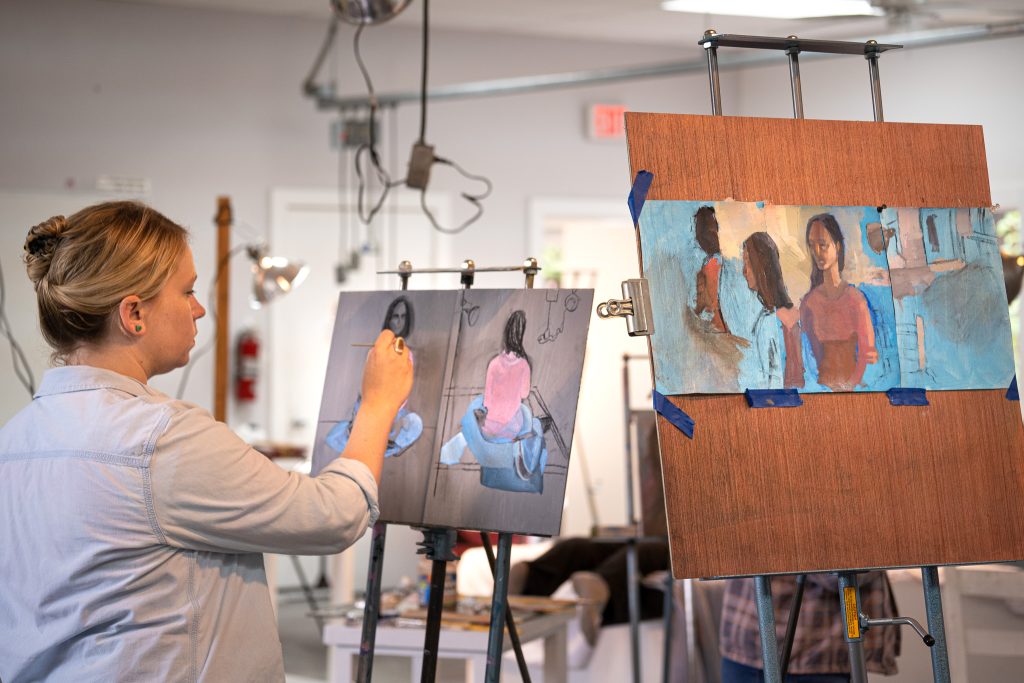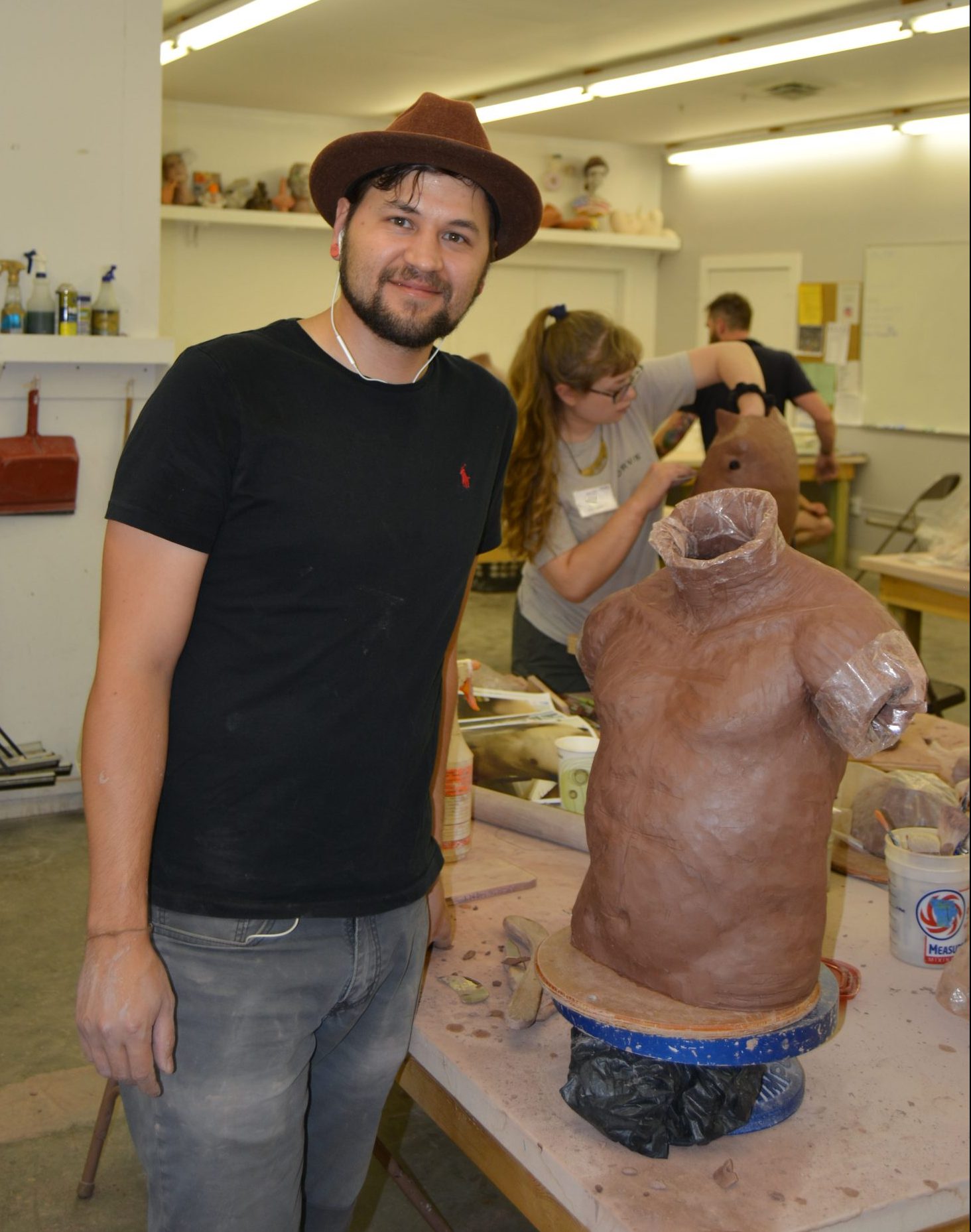Empowered leaders keep traditions alive and thriving at Arrowmont School of Arts and Crafts
There is nothing more thrilling to me than hearing the stories of women who have put their boots to the ground and inspired their communities through nonprofit work. Having spent time in the nonprofit world with a fierce female advocate as my mentor, I feel inspired each time I get to hear their stories. And the leaders of Arrowmont School of Arts and Crafts are no exception. Theirs are stories of fighting to keep traditions alive and working hard to help their community thrive.
East Tennessean Trudy Hughes was just a youngster when she came to know Arrowmont. At just six years old, she fell in love with the work created here, and her family encouraged her to find out more. “I found a weaving that I wanted, and my dad said, ‘You have to interview the artists who made it or someone here on campus who can tell you about it,’” she recalls her father saying, “’and you have to take it back home and share it at show-and-tell.’” Little did she know that a few decades later, this passion for handcrafted art would become part of her journey once again on a more permanent basis. Today, she serves the organization as executive director.
In another seat of the Arrowmont leadership is Margit Worsham, who sits on Arrowmont’s board. Worsham is actually how I first learned of Arrowmont’s legacy. She is by far one of Arrowmont’s biggest cheerleaders. Her first intro to the school was back in 1995 at a painting class. But over time, her passion and drive for helping the organization thrive increased tenfold. During one particular fundraising weekend, Worsham took a printmaking class, and while she will tell you it didn’t go well, she ended up selling the painting she did in the class at a fundraiser to benefit the school. So, she took up painting, solely to benefit nonprofits. “That’s only because I took this class out here,” she says. “So you never know what it will lead to when you come to Arrowmont.”
And then there is Fran Day, whose intro to Arrowmont came when she was just a girl. Arrowmont was a stopping point on her trek to see her grandmother each summer. “I was supposed to always make my granny a present, but it never happened,” she says. “So I would come to Arrowmont, we would visit the craft shop, and I would buy something handmade and take it to her.” After working in other parts of the country, Day eventually found her way back to Arrowmont as Director of Institutional Advancement. She remains in that position today.
These are just a few of the stories that paint the portrait of Arrowmont, and they all have a common thread: a meaningful memory focused on art that they just couldn’t let go of. And for good reason. Arrowmont has for the last 100 years been the keeper of certain Appalachian traditions, and its leaders are ones willing to work as hard as they can to ensure they never leave.

With passion and perseverance, these modern women are not unlike the founders of Arrowmont who believed deeply in its work. The New York-based women’s fraternity, Pi Beta Phi, sent a group of women in the early 1900s to East Tennessee to open a settlement school. The women ventured south by train, eventually making their way by horse and buggy to the quaint town of White Oak Flats.
“They suggested to the guys, the men that were leading White Oak Flats, ‘We would very much like to teach your children,’” Worsham says. But the hardened mountain farmers had no interest.
According to Pi Beta Phi’s historical account, the mountains and rural landscape made it difficult to find an exact location for the school. The women began teaching in temporary quarters. By the summer they held a meeting with the community proposing the creation of a permanent school. A piece of property was identified on Ogle-owned land. The fraternity told the community that they would put in a portion of the cost, but the community would need to make up the difference or they would need to head elsewhere in search of land.
One night community supporter Martha Whaley Huff (whose husband Andy stood at the forefront of the financial community support for the school), had a dream. “Mrs. Huff had a dream the night when the girls were leaving that the Reagans and Ogles and the Huff children were playing in the river, and the fog came rolling down the river and engulfed them,” Worsham says. “And to her, that meant that the men would forever live in ignorance. So she asked her husband to go down there, stop them, and tell them that you will make sure that they get the land.” Huff did so, even Ogle himself put in money, and the full amount was raised. The community held a celebration as Ogle signed the deed, and Pi Beta Phi promised to build a schoolhouse, maintain it and provide the community education.
Within two years, the school became the first school to provide not only education, but also health care. By 1926, the school opened its first craft shop. By 1945, it held its first craft workshop. And by 1967, with the children’s education now in the hands of the county’s public school system, Arrowmont transitioned into a craft education center.
A number of years before the Bi Beta Phi women arrived, White Oak Flats had a postmaster by the name of Radford Gatlin who owned a general store in the town. As I learned more about the history of this area from former community leaders, I was surprised to learn that Gatlin was not well-loved, so much so that he was asked to leave town with the promise that if he did they would name the town after him. And even though he was at odds with his neighbors, it would seem they held true to their word. The town became known as Gatlinburg.

Today, Gatlinburg is a thriving community with Arrowmont smack in the middle. “This was an enterprise of women,” Day says. “And it changed the complexion of this community…This was a subsistence community until this school was founded and these women began to encourage cottage industry. For the first time, there was money in the community, and women had it.”
Strong female voices remain, and the school has been integral in keeping the arts and crafts traditions built here alive. Day adds, “It brought a sense of empowerment.”
In the early days, women, like Hughes’ grandmother, passed these skills down to future generations. But it very suddenly became a challenging task. “Suddenly families had to find others to pass the skill and the craftsmanship on to. Members of their own family—once they moved off for the war or they got educated and they were able to get jobs in the north or whatever happened—didn’t have a need for it and they also didn’t have a desire for it,” Hughes says. “Without Arrowmont, many of the arts and crafts that we value so much now and that have continued to be perpetuated and accentuated, might not even be here.” This is Arrowmont’s legacy.
Students from across the world come here to learn bookmaking, woodworking, enameling, metalworking, drawing, and more. Janet Harper is one of those students. A potter since the ‘70s, Harper began taking classes at the school in the late ‘90s to learn new techniques. Her involvement eventually led her to the Arrowmont board.
“In today’s world, everything is so ephemeral and to be able to make something with your hands and go home and put it on the shelf and see that you actually created something…It’s concrete evidence that there’s a connection between your mind and your hands and your heart.”
The school builds these connections not only through yearly courses, but also through distinguished programs, such as the summer University Fellows program. The Appalachian Craft and Culture Fellows program identifies under-recognized artists and provides them stipends to help them take steps in their careers. The Legacy program brings school teachers from all disciplines to the school each year to learn the value of Appalachian craft. There is even an Art Reach program where local grade-school students come for courses taught by professional artists, a program Hughes says is even more important now as art budgets continue to be cut in schools.



And the organization’s supporters have stood by the organization through it all, from the early days when supporters rallied to help Pi Beta Phi buy the original land, right through to 2013 when the organization had six months to raise $8.5 million to buy the land the school stood on. The city, county, neighbors, and donors across the country came through. Arrowmont purchased the land, and its programs continued to grow.
Then there was the work to build the endowment. “We have a supporter that lives [out of state] and she came and talked to Fran and said, ‘Fran, I think you need to do a capital campaign, and I think it will be fair if you have three years to do it in and you should raise $10 million, and I’ll be happy to give you $10 million to match it,’” Worsham says. ”We started on January 1, 2018, and in November 2019 we had $13 million. This lady, she said, ‘You know, I changed my mind.’”
But it’s not what you think. The donor had indeed changed her mind but it was simply about how much she would give. She doubled her gift. Today the school has a $54 million permanent endowment, and Hughes says the plan is to at least double it so that any person who wants to take a class, “regardless of their ability to pay, would be welcome to come and do so.”
Arrowmont celebrated its 75th anniversary in 2020, and the staff continue to innovate in how they connect people to art. Most recently, the school is slated to open galleries at Knoxville’s Emporium in April, where they will offer small classes, workshops, and installations. And as the organization’s leadership looks ahead at what’s to come, they know that so long as Arrowmont is alive and well, so too will the tradition and culture of Appalachia.
As Harper says, “Arrowmont really speaks to the creativity in your soul.” And with passionate advocates like Day, Hughes, Worsham, and Harper leading the way, there is no doubt those traditions and that commitment to nurturing the creativity in all of us will remain.
To learn more about Arrowmont or to sign up for classes, visit www.arrowmont.org.

Comments are closed.